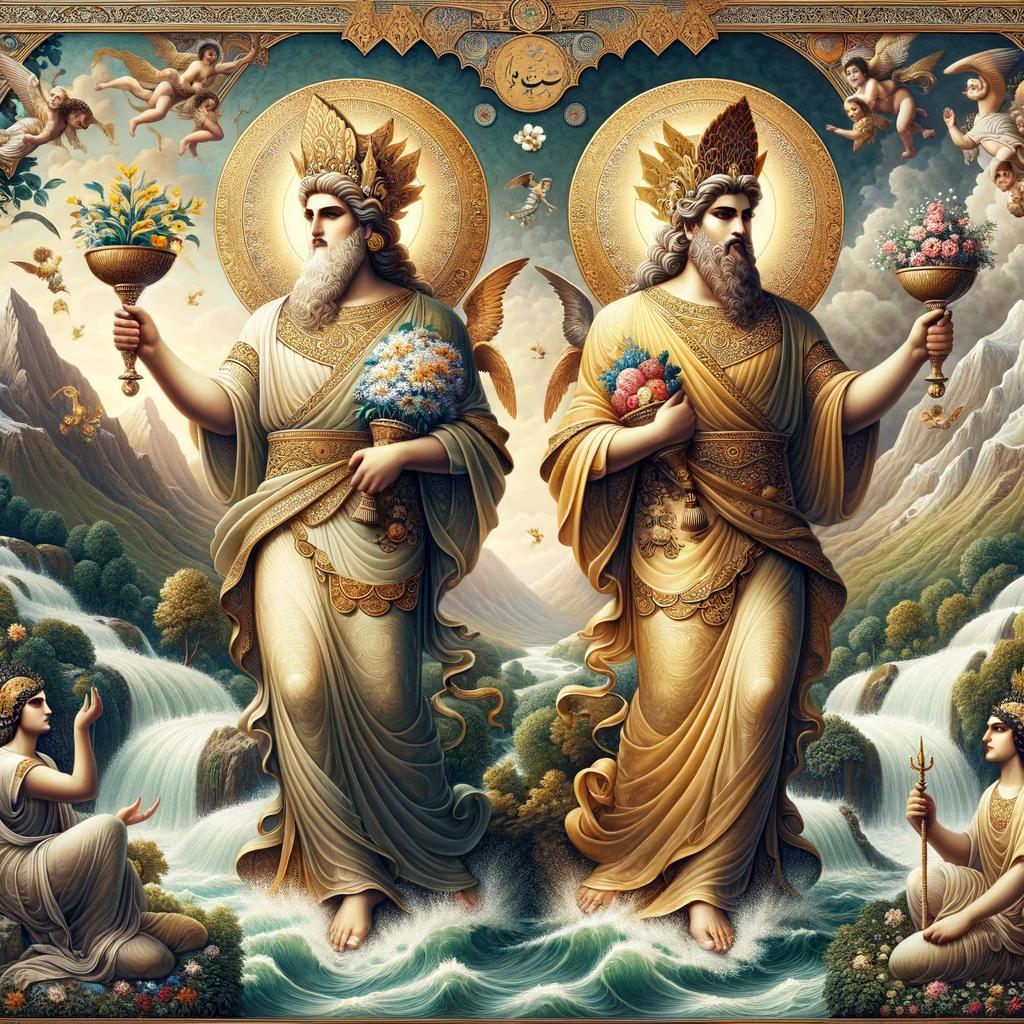Ardvi Sura Anahita: The Persian Goddess of Waters and Wisdom

Ardvi Sura Anahita is a Persian goddess venerated for her association with waters, fertility, healing, and wisdom. With roots in Indo-Iranian beliefs, she is believed to have connections to the ancient Mesopotamian goddess Inanna-Ishtar and shares similarities with Slavic deity Mat Syra Zemlya and Semitic goddess Ishtar.
Introduced in the 4th century BCE, Anahita’s symbol is the lotus flower, and she is honored through the Jashn-e Nilupar festival. Associated with deities like Sarasvati, Inanna/Ishtar, and Aphrodite/Venus, Anahita’s worship revolved around temples and her affinity with water.
The Origins of Ardvi Sura Anahita
Ardvi Sura Anahita, the goddess revered in ancient Persia, has fascinating origins that trace back to the influences of Indo-Iranian civilizations and their connections with the ancient Mesopotamian cultures.
Indo-Iranian Influences and Ancient Mesopotamian Connections
The concept of Ardvi Sura Anahita is believed to be a combination of indo-iranian ideas surrounding the Celestial River and a goddess with uncertain origins associated with the ancient Mesopotamian deity Inanna-Ishtar.
Anahita’s connection to Inanna-Ishtar demonstrates the exchange of religious beliefs and the transfer of divine attributes across different cultures and regions.
Similarities with Mat Syra Zemlya and Ishtar
In addition to her Mesopotamian ties, Ardvi Sura Anahita shares intriguing similarities with the Slavic deity Mat Syra Zemlya and the Semitic goddess Ishtar.
Mat Syra Zemlya of Slavic mythology and Ishtar of the ancient Semitic pantheon correspond to various aspects of fertility, healing, and feminine power, aligning them with Anahita’s domains.
These resemblances suggest a cultural interplay and the universality of the goddess archetype, transcending different civilizations and ethnic boundaries.
By exploring the roots of Ardvi Sura Anahita in Indo-Iranian and Mesopotamian influences, as well as her parallels with Mat Syra Zemlya and Ishtar, we gain a deeper understanding of the goddess’s diverse origins and her significant role in ancient religious beliefs.
Ardvi Sura Anahita as a Persian Deity
As a prominent figure in Persian mythology, Ardvi Sura Anahita holds great significance in ancient beliefs and practices. Let’s explore her introduction as a deity and discover the symbolism and festivals associated with her worship.
Introduction of her Cult in the 4th Century BCE
Ardvi Sura Anahita’s cult gained prominence during the 4th century BCE. Her worship spread across Persia and she became highly revered among the Persian people. Followers of Anahita were drawn to her association with waters, fertility, healing, and wisdom.
The influence of her divine qualities and the allure of her cosmic connections solidified her place in Persian religion.
Symbolism and Festivals Associated with Anahita
Anahita’s symbolism is embodied by the lotus flower, representing purity and rebirth. The lotus’s significance in ancient cultures aligns with Anahita’s divine attributes and her association with water. In honor of Anahita, the Jashn-e Nilupar festival is celebrated, where her devotees gather to pay homage and express gratitude for her blessings.
During the Jashn-e Nilupar festival, elaborate rituals and ceremonies take place, highlighting the reverence for Ardvi Sura Anahita. The festival provides a platform for devotees to offer prayers, perform sacred dances, and make offerings at her shrines and temples.
It serves as a celebration of Anahita’s role in providing abundance, fertility, and wisdom to the faithful.
In conclusion, Ardvi Sura Anahita’s importance as a Persian deity can be seen through the introduction of her cult in the 4th century BCE and the symbolism and festivals associated with her worship.
Her cult attracted followers who were drawn to her divine qualities, and her festivals provided opportunities for devotees to express their devotion and seek her blessings.
Associations and Parallels with Other Deities
Associations and parallels can be drawn between Ardvi Sura Anahita and various other deities across different cultures and mythologies.
These connections provide valuable insights into the cosmic and pantheonic significance of Anahita.
Sarasvati, Inanna/Ishtar, Sauška, Astarté, Aphrodite, and Venus
One of the remarkable associations is between Ardvi Sura Anahita and Sarasvati, the Hindu goddess of knowledge, music, and arts. Both deities share attributes related to wisdom and creative energy.
This connection suggests a shared cultural exchange and symbolism between ancient Persian and Hindu civilizations.
Another parallel can be observed with the ancient Mesopotamian deities Inanna and Ishtar. Anahita’s similarities with these goddesses, known for their roles in love, fertility, and war, illustrate the interconnectedness of ancient Near Eastern cultures.
Ardvi Sura Anahita also finds parallels with Sauška, the Hittite-Hurrian goddess associated with love and the morning star. This connection suggests a cross-cultural influence and shared symbolic significance between the Persian and Anatolian civilizations.
The Phoenician goddess Astarté, the Greek goddess Aphrodite, and the Roman goddess Venus also share certain attributes and roles with Anahita. These include associations with love, beauty, and fertility, further highlighting the universal themes and archetypal aspects of goddess worship throughout the ancient world.
Insights into Anahita’s Cosmic and Pantheonic Connections
The associations between Ardvi Sura Anahita and these diverse deities from different cultures provide deeper insights into her cosmic and pantheonic connections. They suggest a shared understanding of certain universal themes, such as the power of water, fertility, wisdom, and love, across ancient civilizations.
These connections also reveal the interconnectedness of ancient belief systems and the dynamic exchange of ideas and symbolism. The parallels between Anahita and other goddesses emphasize the fluid nature of religious and mythological concepts, transcending cultural boundaries.
By exploring these associations and parallels, we gain a more comprehensive understanding of Ardvi Sura Anahita and her significance within the broader context of divine feminine worship and intercultural exchanges in the ancient world.
The Worship and Role of Ardvi Sura Anahita
Ardvi Sura Anahita, the Persian goddess, held a significant place in the religious practices of ancient Persia. Her worship was centered around temples and sanctuaries, where devotees venerated her with utmost reverence.
Veneration in Temples and Sanctuaries
The followers of Ardvi Sura Anahita would gather in temples and sanctuaries dedicated to her. These sacred spaces were adorned with intricate artwork and sculptures depicting her divine presence. Devotees would offer prayers, sacrifices, and perform rituals to honor and seek her blessings.
Anahita’s temples were beautifully constructed, often in close proximity to water sources like rivers, springs, or lakes. This placement symbolized her association with water, which played a vital role in her worship.
The rituals performed in these temples were led by priests and priestesses, who held a special role in facilitating the connection between the worshippers and the goddess. They conducted ceremonies, chanted hymns, and offered libations on behalf of the devotees.
Anahita’s Association with Water and Healing
Water held immense significance in the worship of Ardvi Sura Anahita. As the goddess of waters, springs, and rivers, she symbolized purification, fertility, and rejuvenation.
Followers believed that by immersing themselves in or pouring water on Anahita’s sacred sites, they could cleanse their souls and receive her benevolent blessings.
The act of seeking her divine intervention in matters of healing, both physical and spiritual, was deeply ingrained in their religious practices.
Devotees sought Anahita’s grace for fertility, well-being, and protection against ailments.
It was believed that her healing powers could alleviate suffering and provide solace to those in need. Many soldiers would pray to her before embarking on battles, seeking her protection and victory.
The association of Ardvi Sura Anahita with water and healing highlights her role as a compassionate deity who brought nourishment, growth, and restoration to the lives of her worshippers.
Who were the followers of Anahita?
How did Ardvi Sura Anahita influence Persian religion?
What were the main attributes and responsibilities of Anahita?
The followers of Ardvi Sura Anahita encompassed a wide range of individuals across different social strata.
Her worship transcended boundaries and was not limited to a specific group or class. People from all walks of life, including priests, merchants, farmers, and warriors, sought her divine blessings.
Ardvi Sura Anahita played a significant role in shaping Persian religious beliefs and practices.
Her presence and influence extended to various aspects of life, including fertility, healing, wisdom, and protection. As a revered deity, she added depth and richness to the religious landscape of ancient Persia, inspiring devotion and guiding spiritual journeys.
Ardvi Sura Anahita was associated with attributes such as fertility, waters, wisdom, and healing. She was believed to possess the power to bestow blessings, protect her followers, and provide relief from suffering.
Her responsibilities included governing the waters, promoting growth and abundance, and granting knowledge and insight to those who sought her guidance.
Frequently Asked Questions about Ardvi Sura Anahita
Who were the followers of Anahita?
The followers of Ardvi Sura Anahita were diverse, encompassing various cultures and regions. She was revered by the ancient Persians who worshipped her as the goddess of waters, fertility, healing, and wisdom.
Her followers included devotees from different social backgrounds, including priests, nobles, and commoners. Anahita’s popularity extended beyond Persia, as she was also worshipped in neighboring regions and was associated with several other deities across different mythologies.
How did Ardvi Sura Anahita influence Persian religion?
Ardvi Sura Anahita had a significant influence on Persian religion. As the goddess of waters, she played a pivotal role in the religious practices of ancient Persians. Water was considered sacred and symbolized purity, fertility, and abundance.
Anahita’s worship emphasized the importance of water in rituals and daily life. Her association with fertility and healing also shaped the beliefs and rituals surrounding these aspects in Persian culture.
Furthermore, Anahita’s cosmological and pantheonic connections showcased her divine presence and established her as a revered deity in the Persian religious framework.
What were the main attributes and responsibilities of Anahita?
Ardvi Sura Anahita possessed a diverse range of attributes and responsibilities.
She was primarily associated with water, embodying its life-giving and purifying qualities. Anahita’s presence in natural water bodies, such as rivers and springs, represented her connection to the life force and regeneration.
As the goddess of fertility, she was believed to bring abundance and prosperity to the land. Anahita’s association with healing made her a patroness of medicine and a source of wisdom in matters of health.
Her nurturing and protective nature extended to her role as a guardian deity, guiding and supporting her followers in their journey towards spiritual enlightenment and growth.
- Anahita’s primary attributes:
- Association with water and its life-giving properties.
- Goddess of fertility, bringing abundance and prosperity.
- Patroness of healing and wisdom in matters of health.
- Anahita’s responsibilities:
- Guardian deity, guiding and supporting her followers in their spiritual journey.
- Protector of the land and its people.
- Divine representation of purity and rejuvenation.
.




















